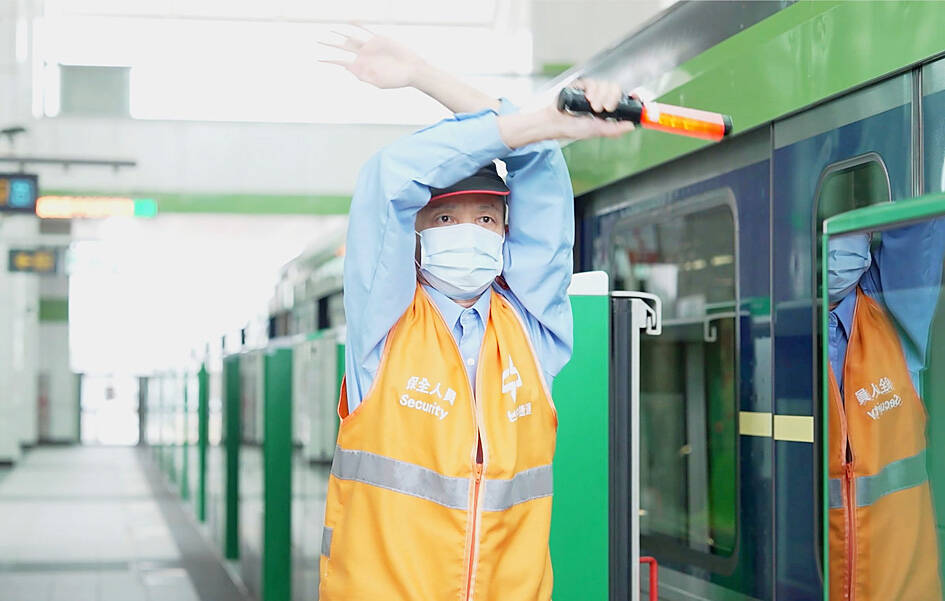Taichung Mass Rapid Transit Corp on Friday announced proposals to improve its protocols after an MRT train crashed into a fallen construction boom, killing a passenger.
On Wednesday last week, a boom separated from a crane atop a residential building under construction near the Feng-le Park MRT Station in Nantun District (南屯), falling 31 stories onto the tracks shortly before the Green Line train departed from the station and ran into the metal wreckage.
Legal academic and indigenous rights advocate Lin Shu-ya (林淑雅) was killed and 10 people were injured.

Photo courtesy of Taichung Mass Rapid Transit Corp via CNA
Taichung MRT proposed three changes to its protocols together with the introduction of two potential hardware updates.
The first change would enhance and standardize its emergency alert hand signals, it said.
If a station employee witnesses a potential accident, they would be required to raise and cross their arms to form an “x” to warn employees on the train, giving them time to contact the system’s operation center and request that the train be stopped.
The second proposal is to encourage passengers who witness an accident to prevent the doors from closing, which would stop the train from leaving the station.
The third proposal would seek to ensure that Taichung MRT employees on trains can readily access their tool bags so it would be easier to stop the train.
Two hardware updates are also to be introduced, including emergency buttons in stations and smart detection devices that are better at recognizing obstacles than existing equipment, the company said.
Lin was discovered underneath a train car about 51 minutes after the collision occurred.
The train ran into the boom at 12:27pm, prompting MRT employees to evacuate passengers and help the injured at 12:58pm.
Company president Chuang Ming-tsung (莊明璁) said that Lin was not discovered for nearly an hour because the company’s standard operating procedures require employees to search the inside of cars once an emergency occurs and the doors open.
Current procedures do not include searching the outside and underneath the train cars, Chuang said, adding that the company would meet to discuss changing the procedure.
The Taiwan Bar Association on Saturday released a joint statement to convey their condolences at losing a distinguished colleague and suggested improvements to public safety procedures.
The association said that companies should employ impartial third-party experts to inspect construction sites using large-scale machinery.
It also said that traffic restrictions should be implemented in areas where construction work is occurring to allow for easy access for first responders in the event of an accident.

SHIPS, TRAINS AND AUTOMOBILES: The ministry has announced changes to varied transportation industries taking effect soon, with a number of effects for passengers Beginning next month, the post office is canceling signature upon delivery and written inquiry services for international registered small packets in accordance with the new policy of the Universal Postal Union, the Ministry of Transportation and Communications said yesterday. The new policy does not apply to packets that are to be delivered to China, the ministry said. Senders of international registered small packets would receive a NT$10 rebate on postage if the packets are sent from Jan. 1 to March 31, it added. The ministry said that three other policies are also scheduled to take effect next month. International cruise ship operators

HORROR STORIES: One victim recounted not realizing they had been stabbed and seeing people bleeding, while another recalled breaking down in tears after fleeing A man on Friday died after he tried to fight the knife-wielding suspect who went on a stabbing spree near two of Taipei’s busiest metro stations, Taipei Mayor Chiang Wan-an (蔣萬安) said. The 57-year-old man, identified by his family name, Yu (余), encountered the suspect at Exit M7 of Taipei Main Station and immediately tried to stop him, but was fatally wounded and later died, Chiang said, calling the incident “heartbreaking.” Yu’s family would receive at least NT$5 million (US$158,584) in compensation through the Taipei Rapid Transit Corp’s (TRTC) insurance coverage, he said after convening an emergency security response meeting yesterday morning. National

PLANNED: The suspect visited the crime scene before the killings, seeking information on how to access the roof, and had extensively researched a 2014 stabbing incident The suspect in a stabbing attack that killed three people and injured 11 in Taipei on Friday had planned the assault and set fires at other locations earlier in the day, law enforcement officials said yesterday. National Police Agency (NPA) Director-General Chang Jung-hsin (張榮興) said the suspect, a 27-year-old man named Chang Wen (張文), began the attacks at 3:40pm, first setting off smoke bombs on a road, damaging cars and motorbikes. Earlier, Chang Wen set fire to a rental room where he was staying on Gongyuan Road in Zhongzheng District (中正), Chang Jung-hsin said. The suspect later threw smoke grenades near two exits

The Forestry and Nature Conservation Agency yesterday launched a gift box to market honey “certified by a Formosan black bear” in appreciation of a beekeeper’s amicable interaction with a honey-thieving bear. Beekeeper Chih Ming-chen (池明鎮) in January inspected his bee farm in Hualien County’s Jhuosi Township (卓溪) and found that more than 20 beehives had been destroyed and many hives were eaten, with bear droppings and paw prints near the destroyed hives, the agency said. Chih returned to the farm to move the remaining beehives away that evening when he encountered a Formosan black bear only 20m away, the agency said. The bear